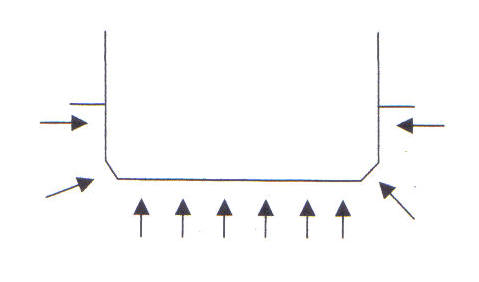Forces acting on a Vessel
Throughout any given moment there are a variety of forces and stresses acting on a boat or yacht. Hardly ever is a boat in a completely static environment, whether it is in the water or on the hard. The basic elements such as water, wind and weight/gravity are working 24/7. Stress is a measure of the load put on a vessel whilst strain describes what happens if the stress becomes too big and the structure deforms.
Types of stresses:
1. Tension – is a stretching force – referred to as Tensile Strength.
Tension – is a stretching force – referred to as Tensile Strength.
2. Compression – is a squeezing force – referred to as Compressive Strength.
Compression – is a squeezing force – referred to as Compressive Strength.
3. Torsion – is a twisting force – referred to as Torque.
Torsion – is a twisting force – referred to as Torque.
4. Sheer – is a chopping force – referred to as Modulus of Elasticity.
Sheer – is a chopping force – referred to as Modulus of Elasticity.
5. Flexural strength – materials ability to yield and return for X cycles.
Flexural strength – materials ability to yield and return for X cycles.
When bending a piece of material, e.g. fiberglass, it is subjected to all the aforementioned forces at the same time. This is very evident when a boat encounters a head sea or swell.
Stress concentrations tend to occur in a structure at abrupt changes in shape such as around holes. Ragged edges are a source of stress and may result in crazing and cracking.
The stresses that act on a vessel can be divided into two classes, Static and Dynamic.
Static Stresses:
These occur when a vessel is floating at rest in still water, with water pressure acting at right angles to the hull. Bulkheads, frames and floors resist these stresses. A vessels hull thickness is increased in thickness towards the bottom of the vessel where water pressure is greatest. Uneven distribution of weights throughout the length of a boat is opposed by buoyancy, and this counteraction results in shearing stresses within a hull. The weight of the engines is a good example of this. Large shearing stress is caused particularly when the boat is hauled out of the water.
Dynamic Stresses:
A vessel when working in a seaway causes these stresses. These stresses can also be divided into two types, namely Rotational and Lateral.
1. Rotational:
Rotational:
a) Rolling
Rolling
b) Pitching
Pitching
c) Yawing
Yawing
d) Twisting or Torsional
Twisting or Torsional
2. Lateral:
Lateral:
a) Heaving
Heaving
b) Surging (often incorrectly referred to as surfing)
Surging (often incorrectly referred to as surfing)
c) Swaying
Swaying
Hogging and Sagging stresses occur when the vessel is subjected to bending longitudinally whilst working in a seaway. Longitudinal stiffening in the form of longitudinal stringers, intercostals, keels and garboard strakes provides resistance. Bending stress is greatest at the mid-ship sections.
Photo courtesy of yachtsurvey.com: A condition in which a hull is sagging with age in also referred to as hogging. It is an accurate indicator that this wooden hull has reached severe degradation and cannot be considered safe.
Shearing stresses are concentrated at the boat’s neutral axis when hogging and sagging. They will also occur in a vertical sense as the distribution of buoyancy alters in a seaway. Large weights, such as those of engines, should be distributed over a broad area by means of engine beds.
Racking stresses are caused by the rolling motion of a vessel, and may cause transverse distortion of the hull. Web frames and transverse bulkheads provide resistance to these stresses.
Pounding in a head sea due to the pitching motion of a vessel causes local shearing stresses as the fore part of the boat slams down on a wave. This is most pronounced in light displacement crafts with full bows.
Panting is also associated with pitching and causes shearing stresses due to the increase and decrease in water pressure as the bow rises and falls through the water as she moves. It is most pronounced in fine bows with a lot of flare.
Vibrations from the engines and propellers are resisted by special strengthening in the immediate area. Local stresses also occur in the vicinity of rigging and deep keels on sailboats. This is minimized by fairing off the structure with fashion plates to distribute stresses more evenly.

